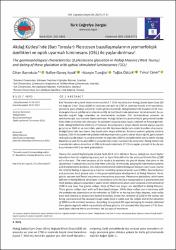| dc.contributor.author | Bayrakdar, Cihan | en_US |
| dc.contributor.author | Güneç Kıyak, Nafiye | en_US |
| dc.contributor.author | Turoğlu, Hüseyin | en_US |
| dc.contributor.author | Öztürk, Tuğba | en_US |
| dc.contributor.author | Canel, Timur | en_US |
| dc.date.accessioned | 2019-08-01T12:10:23Z | |
| dc.date.accessioned | 2019-08-05T16:08:56Z | |
| dc.date.available | 2019-08-01T12:10:23Z | |
| dc.date.available | 2019-08-05T16:08:56Z | |
| dc.date.issued | 2017 | |
| dc.identifier.citation | Bayrakdar, C., Güneç Kıyak, N., Turoğlu, H., Öztürk, T. & Canel, T., (2017). Akdağ Kütlesi’nde (Batı Toroslar) Pleistosen buzullaşmalarının jeomorfolojik özellikleri ve optik uyarmalı lüminesans (OSL) ile yaşlandırılması. Türk Coğrafya Dergisi, 0(69), 27-38. doi:10.17211/tcd.318170 | en_US |
| dc.identifier.issn | 1302-5856 | |
| dc.identifier.issn | 1308-9773 | |
| dc.identifier.uri | https://hdl.handle.net/11729/2076 | |
| dc.identifier.uri | https://dx.doi.org/10.17211/tcd.318170 | |
| dc.identifier.uri | https://app.trdizin.gov.tr/makale/TWpnd01qSXhNUT09 | |
| dc.description.abstract | Batı Torosların en yüksek ikinci zirvesine (Uyluk T. 3014 m) sahip olan Akdağ, batıda Eşen Ovası (60 m) doğuda Elmalı Ovası (1100 m) arasında yer alan ve 2700 m üzerinde birçok zirve barındıran, çevresine göre oldukça yüksek bir kütle görünümündedir. Akdağ Kütlesi'nde Kuvaterner'de meydana gelen buzul şekillerini incelemek ve OSL ile tarihlendirmek çalışmanın temel amacıdır. Bu çalışmada coğrafi bilgi sistemleri ve morfometrik analizler, OSL tarihlendirme yöntemi ve sedimantolojik analizlerden faydalanılmıştır. Akdağ Kütlesi'nin jeomorfolojik gelişiminde birden fazla etken ve sürecin rolü olmuştur. Bu süreçlerin başında karst, buzul, tektonik ve flüviyal gelmektedir. Akdağ Kütlesi'nde etkili olan Pleistosen buzullaşmaları, büyük ölçüde karstik yapıya uyumlu gelişmiş ve 2500 m ve üzerindeki paleo-karstik depresyonlarda kalın plato buzulları oluşmuştur. Akdağ Kütlesi'nde üçü büyük, beş buzul vadisi tespit edilmiştir. Bu buzul vadileri gelişmiş sirklerle başlayıp 2500 m seviyelerinde paleokarstik depresyonlara uyumlu olarak düşük eğimli, geniştabanlı ve büyük ölçüde taban ve yanal morenleri ile kaplı iken 2500 m seviyelerinden sonra vadiler daralıp klasik tekne vadi formu alıp 2000 m seviyelerinde cephe morenleri ile sonlanırlar. Akdağ Kütlesi'nde morenlerden alınan örneklere ait OSL tarihlendirmelerinde 17-21 bin yaşları çıkmıştır ki bu da son buzul dönemi MIS 2 ye denk gelmektedir. | en_US |
| dc.description.abstract | Having the second highest peak (Uyluk Peak 3014 m) in Western Taurus, Akdağ has much higher elevations than its neighboring areas such as Eşen Plain (60 m) in the west and Elmalı Plain (1100 m) in the east. The main purpose of the study is to examine the glacial shapes that form in the Quaternary in Akdağ Mass and to date them with OSL. In this study, geographic information systems and morphometric analyzes, OSL dating method and sedimentological analyzes were used. Due to the relief of Akdağ, it appears as a massive consisting of several peaks over 2700m. Several factors and processes have played roles in the geomorphological development of Akdağ Massive. Karst, glacier, tectonic and fluvial are primary among these processes. Pleistocene glaciations, which were efficient in Akdağ Massif, developed in accordance with the karst topography to a great extent and thick plateau glaciers expanded in paleo karstic depressions which were situated at the altitude of 2500 m and over. Five glacial valleys, three of them are larger, are identified in Akdağ Massive. These glacier valleys start with well developed cirques. While these valleys are in harmony with the paleokarstic depressions at the elevation of 2500 m as having low slope degrees, wide valley base and covered by ground and lateral moraines, below the elevation of 2500 m the valleys are being narrowed and the classical trough valley form is taken and the vallyes end at the elevation of 2000 m with terminal moraines. According to acquired OSL ages belonging to samples obtained from glacier deposits which are products of these glaciers, it is revealed that they were 17-21 thousand years old and this is synchronous the last glacial maximum. | en_US |
| dc.language.iso | tur | en_US |
| dc.publisher | Türk Coğrafya Kurumu | en_US |
| dc.rights | info:eu-repo/semantics/openAccess | en_US |
| dc.subject | Akdağ kütlesi | en_US |
| dc.subject | Buzul jeomorfolojisi | en_US |
| dc.subject | Coğrafya | en_US |
| dc.subject | OSL | en_US |
| dc.subject | Akdağ massive | en_US |
| dc.subject | Glacial geomorphology | en_US |
| dc.subject | Optically stimulated luminnescens | en_US |
| dc.title | Akdağ Kütlesi’nde (Batı Toroslar) Pleistosen buzullaşmalarının jeomorfolojik özellikleri ve optik uyarmalı lüminesans (OSL) ile yaşlandırılması | en_US |
| dc.title.alternative | The geomorphological characteristics of pleistocene glaciation in Akdağ Massive (West Taurus) and dating of these glaciation with optical stimulated luminescence (OSL) | en_US |
| dc.type | article | en_US |
| dc.description.version | Publisher's Version | en_US |
| dc.relation.journal | Türk Coğrafya Dergisi | en_US |
| dc.contributor.department | Işık Üniversitesi, Fen Edebiyat Fakültesi, Fizik Bölümü | en_US |
| dc.contributor.department | Işık University, Faculty of Arts and Sciences, Department of Physics | en_US |
| dc.contributor.authorID | 0000-0001-8598-8596 | |
| dc.identifier.issue | 69 | |
| dc.identifier.startpage | 27 | |
| dc.identifier.endpage | 38 | |
| dc.peerreviewed | Yes | en_US |
| dc.publicationstatus | Published | en_US |
| dc.relation.publicationcategory | Makale - Ulusal Hakemli Dergi - Kurum Öğretim Elemanı | en_US |
| dc.contributor.institutionauthor | Güneç Kıyak, Nafiye | en_US |
| dc.contributor.institutionauthor | Öztürk, Tuğba | en_US |


















